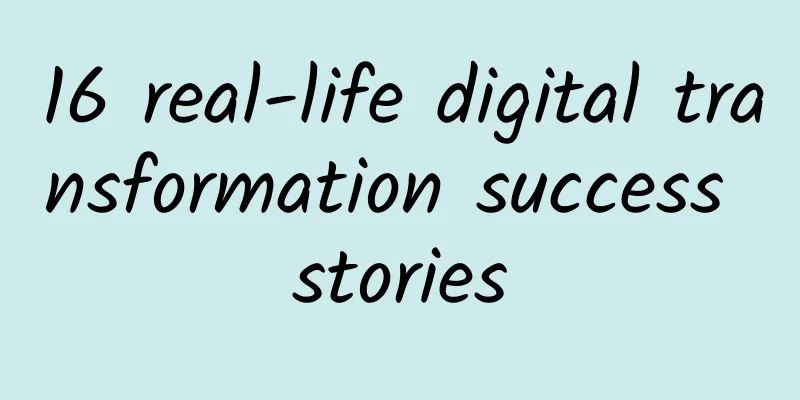16 real-life digital transformation success stories

|
【51CTO.com Quick Translation】CIOs of leading companies such as Sprint, Xylem, and JetBlue have taken the lead in proposing digital solutions to drive business growth and improve operational efficiency. In this article, the author has compiled these real digital transformation examples to provide detailed information on the strategies, implementation efforts, and challenges that IT leaders have adopted. Now, more and more companies are launching digital solutions to improve or acquire digital capabilities, aiming to improve business efficiency or achieve optimal revenue growth. With the continuous emergence of successful cases of digital transformation, this trend is heating up. According to IDC, 40% of all technology spending will be used for digital transformation by 2019, and corporate spending will exceed $2 trillion. "IT leaders who do not fundamentally focus on digital transformation of their enterprises will find that their colleagues in the business departments will turn to outsourcing to meet the needs of business development," said Joseph Pucciarelli, IT executive consultant at IDC.
In order to implement digital transformation on such a wide scale, CIOs need to address challenges such as change management. Enterprise digital transformation often requires CIOs to work more closely with business partners to achieve ideal business results, which is a significant change. In fact, a Gartner survey showed that 95% of 3,160 CIOs said they expect their jobs to change or be realigned as a result of digitalization. Respondents believe that the two biggest shifts in the CIO role will require them to become change leaders, followed by broader responsibilities and capabilities. In addition, technology trends such as cybersecurity and artificial intelligence (AI) will significantly change how CIOs do their jobs in the near future. The stakes are high. According to Harvard Business School, digital leaders achieve higher gross profit, revenue, and net income than the bottom 25% of digital companies. The three-year average gross profit for digital leaders is 55%, while for digital laggards it’s 37%. To help you with your digital transformation efforts, this article has compiled 16 digital transformation efforts being undertaken by some of the world’s leading companies. Below is a brief introduction to the digital initiatives they are undertaking. 1. Armstrong World Industries When CIO Dawn Kirchner-King joined Armstrong World Industries in 2015, the 150-year-old ceiling manufacturer was investing in IT to manage its order book. But IT was also a "black hole cost center" where executives didn't know what they were getting out of their IT investments and whether they were worth it, Kirchner-King said. Soon, Kirchner-King adopted the lean and agile principles that Armstrong’s manufacturing team embraced. She held daily meetings with IT staff and business process owners. She said the meetings provided “a sense of urgency we never had before” as well as transparency for the business, who could see how their money was being spent. That, in turn, made the business more comfortable communicating their critical needs. “With that transparency, we demonstrate a level of trust in what we’re doing,” Kirchner-King said. As for technology projects, Kirchner-King upgraded an ERP financial application to the latest version of SAP, improved and expanded the Salesforce.com CRM suite to Asia and Europe, and migrated travel management to Concur. A new website was created for clients. “Agile really brought speed and urgency to these projects,” Kirchner-King said. Additionally, Kirchner-King said she reallocated investments in mobile to lean toward cybersecurity and other key projects and agility. On the IT side, Armstrong is continually digging deeper into analytics to help it predict quality issues in its manufacturing processes. 2. Putnam Investments Sumedh Mehta, chief information officer at Putnam Investments, said CEO Bob Reynolds asked him to develop a technology business plan to improve the performance of mutual funds, institutional investment strategies and retirement services. Mehta encouraged his business partners to seek solutions they needed, such as tools they could use to provide financial insights to Putnam financial advisors. Mehta added "Facebook-like" collaboration tools to facilitate communication between IT and the business, as well as Google-like enterprise search capabilities and other tools to better automate workflows. Projects underway include retiring legacy applications, migrating applications to the cloud, and investing in data analytics. Putnam has also established a data science center of excellence to explore machine learning techniques to create business insights for clients. All of these initiatives are based on a broader shift toward the agility of IT and business building software in two-week cycles. Mehta said these efforts have sparked interest from business partners who are willing to embrace new ways of working. “With this change, we’ve been able to collaborate more closely with our business people because they’re eager to see what we worked on the night before,” Mehta said. “The companies that embrace this change will be the digital companies of the future.” 3. United States Citizenship and Immigration Services (USCIS) In 2010, when Mark Schwartz was CIO of the United States Citizenship and Immigration Services (USCIS), he pointed out that IT transformation needed to be centered around agile, DevOps, and human-centered design principles. To circumvent the government's single-contractor model, Schwartz brought in vendors to compete for UCSIS' business, calling it Flexible Agile Development Services (FADS). Schwartz said more members can be added to an efficient team. He said the contractor's ability to work with other vendors is part of the evaluation criteria. "The results have been amazing," Schwartz said. The team took on the challenge and released code faster. Schwartz also migrated most of the agency's IT systems to Amazon Web Services, including the organization's E-Verify application. Schwartz joined AWS in late 2017 as an enterprise strategist. "We are cloud-first in everything," he said. Schwartz said he hopes USCIS and other government agencies will institutionalize best practices. "We need agencies to try to do the right thing and share best practices, and I hope that continues with other agencies trying to do that," Schwartz said. 4. Sprint If you've ever wondered how digital transformation works at a telecom operator, look no further than Sprint. "The company, under pressure from big rivals like Verizon and AT&T, in merger talks with T-Mobile and after years of aggressive cost reduction, is now reinvesting in technology," said Scott Rice, the company's chief information officer who oversees digital transformation. The focus is on analyzing data to improve the customer experience. Sprint is using the Elastic Stack open source software to process 50 terabytes of data generated by logs, databases, emails and other sources to measure the performance of the Sprint.com platform. The data helps IT staff determine what problems are hindering the Sprint platform's ability to process transactions, ranging from basic browsing functions to online phone purchases and consumers' online upgrades. Analyzing failures and other latency issues helps Sprint understand when and why customers abandon transactions. Previously, each application team monitored its own software performance, creating large data silos that could not be used to improve performance. "Now this work is based on redesigning the (customer) journey based on data," Rice added. Sprint has also created a Hadoop-based data lake to analyze customer data in an effort to improve the way it recommends products to consumers. For example, a user who has used an Android phone for 10 years will be recommended an Android phone. "This is a lot of information about building a relationship between you and us," Rice said. Sprint's transformation efforts continue in all aspects of the business. "IT teams are at the center of every digital transformation project," he said, adding that he is turning most teams into small and self-directed teams that use agile development to improve software delivery capabilities. 5. Cary, North Carolina, USA You might not associate the term "digital transformation" with municipalities, but in Cary, North Carolina, CIO Nicole Raimundo is trying to build a "Silicon Valley" in the South. She's eliminating more than 100 different legacy applications (powered by the Salesforce.com platform) that the town uses to manage everything from work orders to work permits to onboarding. "I started a platform strategy that allowed us to be successful quickly," Raimundo told CIO.com. The platform includes field service, IT service management, marketing, and collaboration tools designed to help Raimundo get a 360-degree view of Cary's citizens, including details on utility payments and park and recreation registrations. Raimondo and her 30 employees have also developed a “skill,” essentially a small app for Amazon Echo, that lets citizens start processes for work orders and other tools without having to use their phones to initiate such business processes. In addition, recognizing that people increasingly want to facilitate transactions through instant messaging tools, she is also exploring the use of chatbots to let citizens start some processes with government departments through their phones. “The goal is to meet citizens where they are,” she said. Then there’s the Internet of Things, including smart lighting, smart parking and smart recycling on the city’s campus, which she said is an innovation lab for emerging digital tools. As part of this major cultural transformation, Raimondo also established an open workspace and adopted an agile design thinking process to promote the development of minimum viable products. Cary also hosted hackathons, which greatly attracted talent from the local Research Triangle Park, which is home to top technology companies including Red Hat, Cisco Systems, IBM, and Microsoft. She said: "These companies are the driving force for us to attract talent." 6. Xylem CIO Nicholas Colisto has his hands full at Xylem. The provider of water management solutions has five business units that have added several different systems over time. "It was difficult to make technology decisions because the business units were so fragmented," Colisto said. Colisto’s staff spent several years consolidating legacy IT systems in favor of a single platform focused on driving customer engagement, operational efficiency, and growth. The Xylem Integrated System (XIS), also known as Xylem One, leverages social, mobile, IoT, analytics, and other tools in a service-oriented architecture to help employees connect with customers. XIS helped the company generate more than $30 million in net worth in 2016. “We created a business operations platform,” Colisto said. In 2018, IT will continue to execute digital initiatives across all priorities, but will place a greater emphasis on business simplification efforts to better build a culture of continuous improvement, Colisto said. This will include a Global Business Services (GBS) division designed to provide a new service delivery model and roadmap through process improvements, standard technology platforms and robotic process automation (RPA). 7. StubHub When CIO Marty Boos joined StubHub five years ago, the ticket retailer's infrastructure was struggling to handle the massive volume of thousands of tickets sold every day for concerts and sporting events. Boos built an elastically scalable private cloud using VMware, Akamai and Oracle's Linux servers and technologies. After StubHub purchased the Ticketbis platform, in order to better support global ticket transactions, Boos was selecting public cloud providers to perform local payments in 44 countries around the world. "We want to use this method to bring ticket transactions closer to consumers," said Boos. The private cloud will soon become a hybrid cloud to support multiple customer-facing initiatives. With more than 50 percent of StubHub's ticket traffic coming from mobile devices, Booth's team lets sellers take photos of tickets using their phones and post them online. IT is also working with the business development team to add some music and other content to rebuild the StubHub.com platform into a destination site and figure out how to let Facebook friends buy and pay for tickets from each other. "A lot of what we're doing is just the discovery and planning process, making it more convenient for the customer," Booth says. 8. HD Supply Frank Olszewksi is preparing for the day when the construction industry finds itself disrupted by digital trends in service delivery, like Uber and Airbnb. To prepare for that day, the HD Supply CTO moved virtualization and software-defined data centers to colocation facilities (so he doesn't have to manage data centers), where hypervisors and container technology are programmable. That means Olszewski's engineers can change, increase, and decrease computing resources with the click of a few buttons. Olszewski said that this architecture, combined with customer-facing mobile technology, allows HD Supply's maintenance and field service personnel to use smartphones to take a picture of the parts, and then query the company's back-end system to find the warehouse where the parts are located. Ideally, this will enable HD Supply to provide same-day delivery services to customers. Olszewksi said that in the future, HD Supply can rent other distribution centers as needed, similar to the model of Airbnb. Olszewski said: "Six or 12 months from now, I need to be ready to handle this workload. We will test and study it." 9. JetBlue Airways At JetBlue, CIO Eash Sundaram has deployed high-speed internet and streaming services, mobile payments and other tools to improve the passenger experience. Earlier this year, JetBlue launched JetBlue Technology Ventures (JTV) to seek venture capital for startups that want to introduce machine learning and analytics to the travel market and provide new ways to serve customers. It sees this as another channel for innovation. "If you put all the work on the parent company, then things won't move as fast as you want to move forward," said Sundaram, who is also eyeing near-field communication technology to replace self-service kiosks and check-in desks. 10. Domino’s Pizza Domino's Pizza already offers several features that allow consumers to place orders from any computer. The company's AnyWhere platform allows you to place orders from smartphones, smartwatches and smart TVs by simply typing in your order on the Domino's Pizza website and by tweeting and texting emojis. "These options drive our entire mobile and digital platform," Kevin Vasconi, Domino's Pizza CIO, told CIO.com. "Millennials love it." The challenge for Domino's Pizza right now? Getting Dom, the company's voice-activated virtual assistant, to understand and facilitate the different ways people order food via voice. 11. Target Target had been on a fitful path to digitalization, and a major data breach in 2013 did little to help its digital efforts. To help drive their digital transformation, the company hired Mike McNamara, Tesco’s CIO, who had launched multiple digital initiatives for the U.K. department store chain while at Tesco. McNamara spent much of 2016 shifting the software development model from outsourcing to insourcing and overseeing custom software development, including the development of a new supply chain application to better align inventory with consumer demand. 12. Walmart Like Target, Walmart has been redesigning its software stack to a custom platform that includes a new search engine and multiple cloud applications. Based on the OpenStack platform, Walmart's new e-commerce platform is designed to help retailers better compete with the OpenStack cloud platform. In fact, open source is an important part of Walmart's digital transformation. Earlier this year, Walmart Group launched the OneOps platform, which allows programmers to test and switch between different cloud providers, which is a crucial advantage for companies adopting a hybrid cloud model. 13. Capital One Financial Corporation Capital One has built a massive banking and credit card business on the strength of its solid customer service, helped by strong digital capabilities. Its mobile banking app was the first to support Apple’s TouchID biometric software. In 2016, the company’s bank became the first to enable voice-activated financial services transactions through Amazon.com’s Alexa virtual assistant. Now, Chief Information Officer Rob Alexander is overseeing a major transformation of development operations to facilitate faster software development. “The winners in banking are going to be the ones who recognize that technology is going to play a really central role in the future needs of consumers,” Alexander told CIO.com. “We have to be good at developing software.” 14. CVS Drug retailers are rarely mistaken for digital innovators. CVS is changing that by integrating its website and mobile app. The company later hired Brian Tilzer, director of development, to lead the company’s digital strategy, and CVS CIO Stephen Gold, rather than complaining and lamenting that his position was threatened, as many CIOs do, welcomed Tilzer into the C-suite. To that end, in 2015 Tilzer and Gold opened a digital innovation lab in Boston. Early projects, including digital prescription and insurance card scanning and integration with the Apple Watch, have yielded results. The company has also integrated technology from startup Curbside into a mobile app that lets shoppers order and pick up items at CVS stores. Gold says the innovation team’s job is to iterate quickly. “Part of innovation turns out to be something that doesn’t really work, and that’s great as long as you find it early in the innovation process rather than later,” Gold says. 15. Walgreens CVS's main rival, Walgreens, has also been steadily transforming, with CIO Abhi Dhar taking over as head of the company's digital strategy in 2015. He called it a "maniacal focus on the customer," redesigning the company's mobile app to allow consumers to manage their medication schedules from an Apple Watch and letting Balance Rewards members earn and redeem points using Apple Pay. 16. Subway Subway's transformation is just getting started, but Chief Information Officer Carman Wenkoff is leaving himself little wiggle room. He has hired more than 150 technology, marketing and operations professionals to help revamp the company's mobile app and redesign the sandwich chain for the future, including self-service kiosks and other features. Wenkoff also took on a development director role this summer, which he said will help align corporate strategy. Original article address: https://www.cio.com/article/3149977/digital-transformation/8-top-digital-transformation-stories-of-2016.html [Translated by 51CTO. Please indicate the original translator and source as 51CTO.com when reprinting on partner sites] |
<<: In the DT era, what is the trend of data center cabling?
>>: Overview of the five major 5G wireless technologies
Recommend
Why IoT needs LPWAN
LPWAN deployment for IoT devices aims to provide ...
Wireless communication technologies within reach in daily life - WiFi, Bluetooth and NFC
WiFi Wi-Fi (Wireless Fidelity) is a wireless LAN ...
H3C: The key to computing-network integration lies in the efficient coordination of computing power and transportation capacity
On September 26, the "2022 China Cloud Netwo...
TheStack Spring Promotion: KVM in 8 data centers including San Jose/Los Angeles/Phoenix starts at $10 per year
TheStack is an early established overseas server ...
Come and have a look!!! TCP/IP knowledge points that you often overlook
Internet Layer Protocol In the DoD model, the Int...
my country has built the world's largest 4G network
[[181278]] On January 6, the Ministry of Science ...
[Restock] Bricklayer Los Angeles CN2 GIA (DC6/DC9)/Japan Softbank special price $46.6/year
Bandwagonhost has restocked the special annual pa...
Enlightenment on using Smallcell to solve deep network coverage in the post-5G era
1. Current status of network coverage in the post...
China Unicom's aggressive push to phase out 2G networks is likely to shoot itself in the foot
China Unicom is currently actively promoting the ...
5G news is coming, and the national trial commercial use will start in mid-to-late October!
[[426617]] After much anticipation, the long-awai...
Understand 3GPP 5G versions and the features of each version
While for years cellular technology has been prim...
UCloud: Shanghai/Beijing cloud server annual payment starts from 62 yuan, Hong Kong/Taiwan cloud server annual payment starts from 150 yuan
The tribe once shared information about UCloud, U...
New challenges for operation and maintenance in 2018: Three experts tell you how to achieve intelligent operation and maintenance
[51CTO.com original article] With the trend of cl...
RAKsmart Hong Kong VPS simple test, three network direct connection/Telecom CN2
A few days ago, we shared information about RAKsm...
F5 is targeting five directions for application services in the future. Wu Jingtao explains F5's ABCDE
[51CTO.com original article] At 9:00 am on May 22...



![[11.11] TmhHost 30% off, Los Angeles CN2/Japan Softbank/Hong Kong CN2 monthly payment starts from 21 yuan](/upload/images/67cac044abcf4.webp)





